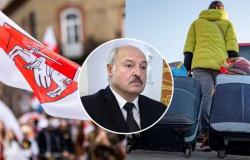In 2004, Lithuania joined NATO quite quietly, much more attention was focused on the upcoming EU membership. However, the importance of NATO became more evident a couple of years ago, when Russia launched a large-scale invasion of Ukraine and Lithuania began to doubt whether the NATO umbrella is really safe.
Lethargic sleep
The first decade of Lithuania’s membership was calm – we had to take care of integration, modernization of the army and other “domestic” matters, while NATO was not concerned with the threat of Russia, but with peacekeeping missions, the fight against terrorism and even ecology.
We watched rather relaxed when the Russian army invaded Georgia in 2008. We believed that this would not be possible in the NATO space. But it was already an alarm clock. A few months after the start of the war in Georgia, the defense ministers of Estonia, Latvia and Lithuania at that time raised the issue of collective defense plans for the Baltic region in London, and in 2010 this idea became a document. At that time, Lithuania took another step towards a safer region, but, looking in retrospect, it is obvious that more than one year will have to pass before NATO wakes up.
The IQ editorial team writes about business, politics, culture and other important social phenomena. We create quality and exclusive content. We invite you to support us by subscribing to our magazine for yourself or people close to you on our subscription website https://prenumeratoriai.lt/. For those who have ordered the magazine for a year – all content on the iq.lt website is free.
But at the same time as the Russian tanks were rolling towards Tbilisi, the first waves of the world financial crisis arose, which in 2009 plunged Lithuania into a deep recession. The Government of that time began to reduce all public expenditures, as well as for defense. In an interview with IQ, Rasa Juknevičienė, who served as the Minister of National Defense at the time and is now a member of the European Parliament, said in an interview with IQ that the reduction of military spending was an extremely sensitive issue, because it was at that time that the armament in the Kaliningrad region was intensified, and in the “Zapad 2009” exercises organized by Russia, training was given to cut off the Suwalki corridor, about which the world has not yet spoken. “However, even President Dalia Grybauskaitė did not agree that we could single out the military and reduce its expenses less than pensioners or other sensitive areas,” said R. Juknevičienė.
But it would be too simplistic to blame the financial crisis alone for the Alliance’s decades of lethargy. The idea that the 21st century was formed as a result of the technological breakthrough also helped to doze off. the success of wars will not be determined by the size of armies, but by technological progress. NATO was dominated by the opinion that military conflicts would be short and precise. 2009-2014 Anders Fogh Rasmussen, who served as NATO Secretary General, initiated the NATO modernization project and created a new strategic direction for the Alliance, which became the slogan of the phrase “intelligent defense”. smart defense). We cannot verify how effective such a strategy is, but it is clear that by 2014 Conventional threats did not exist on NATO’s radar – they were simply underestimated.
Finland, according to R. Juknevičienė, is an excellent example that reveals how traditional defense strategy measures help to keep the country well prepared and society alert: “Despite the fact that Finland did not belong to NATO, it, like other members of the Alliance, was under pressure to give up that “old” way of thinking – conscription, reserve training, that’s why today Finland is the only EU country with approximately 80% during polls, people say that they would defend the country with a weapon.”
Reality is knocking at the door
Lithuania welcomed its tenth birthday in the Alliance with a different mood. On its eve, in 2014 In March, the Kremlin organized a “green men” operation, annexing Crimea in a flash and almost without casualties. A similar scenario was tried to be implemented in Donbass, but when the Ukrainians resisted, a war broke out. The beginnings of these events lead to 2013. At the Eastern Partnership summit held in Vilnius on November 15, the then President of Ukraine, Viktor Yanukovych, refused to sign the association agreement, which provoked huge and bloody protests in Kyiv. In the end, V. Yanukovych fled to Russia, and the Kremlin responded, leading to the current situation.
Russia’s demonstrated methods of hybrid warfare made the West question its readiness to counter such a threat, and this soon turned the defense budgets of NATO members. As stated by R. Juknevičienė, in 2014 events in Ukraine saved the Baltic countries from a possible Russian blitzkrieg scenario – during his last visit to the Pentagon in 2012. she heard assessments by US military intelligence that if NATO did not take action and Russia continued arming Kaliningrad, in 2019 it would already be ready to test the unity of NATO in the Baltic states. Then NATO woke up… Or so we thought until 2022.
Until 2014 Conventional threats did not exist on NATO’s radar – they were simply underestimated.
NATO’s first goal was to increase defense spending by Alliance members to 2 percent. GDP. At that time, only the United States (3.72 percent), the United Kingdom (2.14 percent) and Greece (2.22 percent) had achieved such an indicator, and the overall average, excluding these three countries, was 1.23 percent. GDP. In five years, Lithuania increased its defense spending from 0.88 to 2 percent, but the overall average of European countries and Canada even in 2023. did not reach 2 percent
Despite the set financial goals for restoring NATO’s capabilities, already in 2014 there was talk of the declining contribution of European countries to the security of the region, but the Old Continent itself was slow to take such an initiative. 2016 gave impetus to this. Donald Trump has been elected president of the United States. “D. Trump’s demand to allocate more resources in Europe nevertheless worked and gave a positive effect – from the few European states that allocated that 2 percent, a dozen appeared”, – Minister of National Defense Arvydas Anušauskas, who resigned in March, told IQ.
After 2014 The attention of the West turned to the Baltic side as well – for the first time it was recognized that Russia, repeating the Ukrainian scenario, may try to destabilize the situation in the Baltic countries as well. “There is a real danger that Russia will try to destabilize the Baltic countries”, – in 2015 then UK Defense Secretary Michael Fallon told the media.
But the headlines announcing the danger were circulating in the Western media like nothing else, and the most important word of the news was enclosed in quotation marks: “Baltic countries are in ‘danger’.” For Lithuania, this meant that while Russia is stuck in the east of Ukraine, the most vulnerable NATO countries have to prepare a diplomatic front in the west of the alliance.
D. Grybauskaitė told foreign media: “If Vladimir Putin is not stopped in Ukraine, he will go further. <...> Everyone declares that NATO Article 5 will work. However, this will not stop Mr. Putin from his plans if he does not see real actions by European and world leaders.” These words were said in 2014, but they sound as if they were taken from yesterday’s news. Lithuanian military command sources who spoke to IQ said that Lithuania was often viewed as hysterical when communicating with representatives of Western armies. Did that hysteria have any positive effect? It is difficult to say, because even in 2016 After NATO’s decision to deploy advance forces in the Baltic states and Poland, Russia’s status as a threat was still unclear, and we had to wait until 2022 for the West to recognize that Russia is a threat after all. February 24th. However, Lithuania’s constantly repeated phrase “Russia is a terrorist state” laid the foundation for NATO’s public position.
So what are the most important steps NATO has taken since 2014? According to A. Anušauskas, the most significant decisions for Lithuania were three. in 2016 The decision to deploy NATO forward forces in the Baltic states was made in Warsaw, and this brought a German-led battle group to Lithuania. in 2022 A declaration was approved in Madrid stating that “the Russian Federation poses the greatest and most immediate threat to the security and peace of the Allies” and, thirdly, in 2023. A communique was signed in Vilnius regarding NATO’s “iron commitment to always defend each other and every centimeter of allied territory”.
The renaissance of NATO
After 2022 Europe not only woke up, but also took action. But these two years have exposed even more of NATO’s weaknesses. Europe is too dependent on the United States, and that dependence will worsen if Trump returns to the presidency, threatening to withdraw from the alliance altogether. European military power is weak, ammunition depots are empty, and industry is just beginning to be mobilized.
“After the start of the war, the production of the European defense industry during the year did not develop as much as we expected – said A. Anušauskas. – When the EU initiative to transfer one million artillery shells to Ukraine was announced, it sounded extremely strange to me. Then I told the (foreign defense – IQ post) ministers that we understand that there is no production now. It is twice as much as expected.”
Europe’s belief that the defense industry would move as soon as countries placed orders turned out to be a mirage. After receiving the orders, it turned out that additional development was required to fulfill them, and there was no time. According to A. Anušauskas’s forecast, the expanding European production capacity should allow the production of one and a half million projectiles per year only at the end of this year. “But it took time. No one saw such threats. We thought that Russia would kick back and follow the path of political dialogue,” the former minister admitted.
By turning only one country into its Trojan horse, Russia can manipulate any institution that requires unanimous decision-making.
Another no less important challenge for NATO in the last decade was the different positions and interests of the members, which prevent the Alliance from faster expansion. Let’s remember – at first Turkey blocked Sweden’s accession to NATO, and later Hungary also contributed to the blocking. It took almost two years since Sweden’s request to overcome the hurdles between these two countries. Ambassador Deividas Matulionis IQ, the head of the Lithuanian delegation to NATO, said that NATO is a different organization than the EU – in it each country has one vote and there is no qualified majority, and introducing a veto system would be impossible due to the meaning and form of the organization itself.
 ELTA
ELTAD. Matulionis.
“Nevertheless, reforms are being thought about, and when NATO’s strategic concept was being considered, it was talked about a lot. Perhaps a variant like “coalition of the willing” could be used more often. coalition of willing) – states that are ready to participate in solving one or another problem, excluding the entire NATO. This practice could continue to be more widely used, because sometimes one party vetoes important issues and we again have to look for compromises, and they are not the most rational”, explained D. Matulionis.
Philip Wasielewski, director of the Center for Intelligence and Unconventional Warfare Research at the US Foreign Policy Research Institute (FPRI), agrees and says that NATO needs to find ways to reform: “When Russia turns only one country into its Trojan horse, it can manipulate any institution that requires unanimous decisions reception to which that country belongs. NATO and the EU must reform to prevent this.”
You don’t have to look far for examples of new cooperation formats among NATO members. in 2016 The agreement signed at the Warsaw summit on the deployment of NATO advance forces in the Baltic countries and Poland was based precisely on the principle of bilateral agreements. States were allowed to agree on specific strategic conditions themselves to avoid disagreements over how the plans should be implemented. “Not all members are enthusiastic, it can be seen,” said A. Anušauskas. – Consequently, the implementation of the decision will be based on multilateral formats. This certainly does not mean the breakup of NATO, but it is too early to predict what that will look like. However, it is possible that blocs of NATO’s active members will form, which will lead to a transition to multilateral formats, where decisions will be made separately from NATO. De facto it’s already happening.”
Interview with the representative office of Lithuania to NATO as the head ambassador Read about David Matulionis here.








